Melissa Ridley Elmes
Lindenwood University
On March 11, 2020, as the COVID-19 pandemic was beginning to take shape and reveal its impact globally, the faculty at my university received a message from the President’s office: On the following Monday, March 13, we would move online for the week to evaluate our position within the pandemic’s spread. On March 16, this initial, temporary pivot to online instruction was converted to fully remote learning for the duration of the semester and campus was closed, our students instructed to return only to pick up their belongings and move out of the dorms by March 22. Our spring break was March 9-13. This meant, effectively, that most of our students were sheltering-at-home for that week and, as one of my colleagues wryly observed, “laundry goes home for spring break, books may not.” The following week, students were working on logistics of getting moved off campus and rearranging their lives, as we all watched the number of COVID-19 cases rising steadily each day. Needless to say, even above and beyond basic logistics of students without books and course materials, the stress and anxiety were palpable. How do you teach in these conditions? Technology proved to be both essential to our ability to continue teaching remotely, and, also, in many ways, a series of problems to be resolved along our way to finding the means by which we could successfully conclude our spring term. This essay details the pivot I made to teaching my on-the-ground Chaucer class online as a case study demonstrating how one professor navigated these circumstances, and provides some takeaways regarding what I learned along the way about teaching Chaucer in what has widely become deemed the “digital age.” I present an overview of my approach and a few specific examples of how I translated face-to-face instruction and assignments into digital learning experiences for my students, followed by reflection on how this experience has affected my thinking about course design going forward regardless of whether I am teaching face-to-face, online, or in hybrid fashion.
There is a perception among modern faculty that our students are “digital natives” and, therefore, that they know far more about technology and navigating the internet and online classes than is often the case. At my institution, a private midwestern university with a student body predominantly comprised of first-generation and non-traditional students and a strong international presence, as well as a large student-athlete community, I found during the pivot to remote teaching in spring 2020 that a much larger number of students than I had anticipated had never taken an online course and were unfamiliar with Canvas, our learning management system; some had extremely limited or intermittent access to the Internet, especially students living in rural areas with dial-up internet, students sharing a computer and network with parents and siblings also working from home, and international students in countries which employ rolling internet blackouts; and others did not have software at home which we take for granted in campus computer labs, such as the word processing applications, PDF readers, and photo processing and manipulation available through Microsoft Office and Adobe Suite, and were unaware that there are comparable open-access programs available that could help them achieve the same results.1 In fact, many of the students enrolled in my courses had limited understanding of educational technology or of using the Internet for educational purposes. I am not alone in this observation; since Mark Prensky’s initial (and controversial) coining of the term “digital native” in 2001 many scholars have conducted studies demonstrating this term’s limitations in describing modern students and its potentially negative effect on student learning through pedagogical choices made with the assumption of its widespread applicability.2 The reality is that while it seems that today’s students “have spent their entire lives surrounded by and using computers, videogames, digital music players, video cams, cell phones, and all the other toys and tools of the digital age”3 this is both not always the case, and not a guarantee that those uses of technology readily transfer to academic repurposing.
Drawing on 20 years’ teaching experience, including teaching at least one online course per year since 2014, and, most importantly, having myself recently taken online-only courses and thus having a student’s perspective on what worked and didn’t work for me as an online learner, I was able to successfully help my students negotiate this experience. Upon learning that our temporary pivot had been converted into a permanent one for the semester, my immediate response, like that of my colleagues, was a focus on logistics: where were my students? What kind of internet access did they have? How familiar were they with online learning environments? What materials did they have with them? What was their family and working situation when they did not have the support of a campus ecology? What about accessibility concerns, where a student who was fine in on-the-ground courses might have an issue that hampered their ability to succeed in a remote setting? I sent a survey to ascertain what my students could be counted on to know and have access to (Appendix A). The results of the survey persuaded me of two things: first, there was a real and significant divide between students who were comfortable with online learning and students who had not undertaken it before, and second, there was no ethical way I could deliver my courses synchronously, with students in so many time zones. My primary goal once I reviewed those survey results was to find a way to make my courses accessible and completable for students regardless of their familiarity or experience with online learning, regardless of the environment they were operating in, and, as much as I was able to manage it, despite the emotional and psychological impact of the ongoing pandemic. This meant I had to take a three-prong approach: revising course design for maximum accessibility and flexibility; incorporating principles of universal design to reduce confusion and distractions; and determining the most effective ways I could maintain connection with and support for my students both as individuals and as a learning community through my pedagogical choices.
To accommodate our sudden diasporic reality, I converted my courses to asynchronous online delivery, drawing on my experience as a graduate student in our online MFA in Writing program, which services students around the world, and on my own training in online instruction. In doing so, I made some key changes to how I operate courses online with learning psychology in mind. Generally, when teaching an asynchronous online class, it’s preferred to have the entire course available to students from the first day, using the Learning Management System (LMS) adaptive release function to open each module to them as they complete the last one, so they can work at their own pace. Students used to taking online courses are therefore not deterred by a long string of uncompleted assignments in the LMS calendar and to-do tasks list (in our case, Canvas) because they are accustomed to it and understand, through their experience, that this is a normal workload for online learning and they can complete it successfully. However, my on-the-ground students were used to following a paper syllabus and doing work on a weekly basis, and assignments listed on paper look and register psychologically very differently than they do as a string of uncompleted work in the Canvas course calendar. I realized my students were so overwhelmed that many would shut down if it looked impossible to complete the course, even if it were the same amount of work we would be doing under normal circumstances.
Rather than setting up the rest of the course through the end of the term, then, I took it one week at a time, each Monday creating a module labeled with the dates of that week. For each week, I included a landing page with an overview of information they needed—what we were reading, what they needed to do, things I wanted or needed for them to know going into the week’s work about my availability and grading and meeting schedule, and any support materials such as links to helpful websites for the readings and work at hand in a given week. This weekly “START HERE!” page gave them an advance organizer so they understood what was expected of them and what could be expected from them of me. I then set up a series of discussion boards for each week—one for each reading, to keep things organized. Assigning the reading of this page as the first assignment of the week so it showed up in their “to-do” list ensured my students knew they should not skip reading this page (a common shortcut even online students take, but which would, in this case, have exacerbated the frustration and confusion of this pivot.) To further help reduce frustration and confusion, I loaded my lecture notes and short video explanations directly into the discussion board for each reading, so my students didn’t have to go hunting for them in “files” or elsewhere in the LMS. They had until Wednesday of each week to complete their initial posts, and then until Sunday at 11:59 p.m. to respond to at least 5 of their classmates’ posts. I encouraged them to visit the discussion board several times throughout the week rather than simply going in on Wednesday and then again on Sunday, to try to preserve a sense of the ongoing give-and-take of a class discussion and to spread the work out a little rather than their sitting down and trying to do it in two large chunks of time. Some students took that advice, but most did not. They did, however, appreciate my effort to help them manage their learning and workload through such time management tips.
Regarding other assignments beyond reading and discussion, as the term wore on, I also made some key changes to how I handled these in order to better support my students as they experienced increasing uncertainty, stress, and trauma with the ongoing pandemic. Generally, in my upper-division seminars, I require a high level of independent thinking, rarely giving my students prompts to write and think from but rather, asking them to conduct original inquiry based in their reading. With the online pivot requiring them to learn many new modalities and procedures for their various classes most were intellectually fatigued, and without the continual organic development of multiple ideas in each in-person class session many grew intellectually stagnant. This was particularly true in Chaucer, where my students’ lack of familiarity with Middle English and medieval England, already a struggle for them in face-to-face learning, was amplified in the online pivot. Once I learned this issue was becoming a deterrent to their feeling they would be able to successfully complete the course, a realization gleaned through individual conferences and the quality of their work, I began providing extra contextual information, more linguistic examples and explanations, links to online resources for every reading and assignment, and an explanation for each activity regarding what they were doing and how it contributed to meeting the course objectives, replicating as much as possible the kinds of support I would have given them in person as a matter of course and informally during class discussions. While some did not take advantage of this assistance, simply muddling through assignments without using these aids to get them done, those that did make use of these additional supports reported that they found the online to more or less equate with their on-the-ground experience so far as rigor and support were concerned, indicating satisfaction with their learning experience after the pivot. I have, since, continued this practice in all my classes regardless of modality, in particular articulating much more thoroughly than I did in the past what we are doing, why we are doing it, and what they can expect to gain by way of skills, competencies, and content knowledge upon completing each assignment.4
For their semester-long commonplace book assignment, which required them to complete a minimum of twenty entries spread across several categories of assignment, my students had been working independently, doing entries as they wished outside of class with a checkpoint every four weeks or so. However, after moving online that level of independent work proved overwhelming: work that didn’t show up in their to-do calendar on Canvas tended to be forgotten, and they couldn’t think of things to add to the book on their own without the benefit of in-person class discussions. To support the completion of this major term project, I gave them an assignment each week to select from a set of prompts I provided and complete 1 or 2 entries. I also tied this work to a discussion board where they could share their creative work with one another. This approach enabled them to continue to make progress towards the successful completion of the project, and it also gave them the opportunity to continue to be inspired by one another’s work—creativity begets creativity. This proved to be a successful translation of the assignment for their online learning environment, and all of my students were able to complete their Chaucerian Miscellany well and in timely fashion.5
My essential focus through all of my alterations to the course was logistics, mainly regarding accessibility, flexibility, and making sure my students felt supported and had the resources and information they needed, which looks very different online than it does in face-to-face classes. Where in face-to-face learning assignments might be due on any of the days we meet, upon moving to asynchronous online learning I converted all of the due dates for assignments to Sunday at 11:59 p.m., giving my students the time and space to work at their own pace through the week to accommodate family rhythms and needs and work schedules. Where in face-to-face learning I would give them little tidbits of information they needed at the beginning of each class session, when we moved to online learning I was mindful of the volume of emails they were receiving from the university and all of their professors. Rather than sending them several emails throughout the week, I sent them a weekly announcement/email each Friday that summarized the week’s work, looked ahead to what they would be doing the next week, gave them any other information or support materials I thought they would benefit from, and offered a video of me giving a pep talk or other encouraging information. This proved to be an important support for them both academically and personally, and a good means of providing it—they needed the information and wanted me to reassure them and help them stay on top of things. Many of my colleagues sent their students separate emails with every assignment, and some of my students reported they received so many emails from other professors they just stopped reading them, and expressed gratitude to me that my emails only came out once weekly and were helpful and supportive.
Each week, I also gave my students a “check-in” thread—a discussion board that was just community-building and only counted for participation. This was an easy and low-stakes way for them to stay connected without feeling the pressure of completing an assignment for a grade. I would have them do things like post a gif or meme of how they were feeling right now, or a 5-song playlist for a character, or a recipe they love, or “bring your pet/sibling/roommate to class”—just little things that let them feel human connection with one another in a time that felt deeply impersonal and isolated. These discussions also had the added benefit of cuing me in when students who were not completing much, if any work were still connected to the class—they would almost always post in these threads, if in none of the others, which enabled me to reach out to them and encourage them to complete the other more formally assessed assignments, and to alert our student services and Dean of Students office that those students might benefit from more support.
There are a LOT of bells-and-whistles apps and pedagogical tools out there, but the reality is that if you are not going to teach your students how to use them, they are not helpful or effective. In the middle of a pivot to remote learning during an online pandemic, my students were struggling to learn the basic materials of my course. I did not want them to have to “learn how to learn” any more than they already were experiencing—as I’ve noted, for many, just figuring out Canvas was a challenge. So, I did not use third-party tools for the most part, with the exception of Microsoft Teams for meetings with individual students and of Perusall, a community annotation platform, for collective reading and annotation work, which we did with Chaucer’s dream visions, near the end of the semester, once they had all become acclimated to the online learning environment and could devote a little time and mindspace to learning the new platform. Perusall is now available as an embedded application within Canvas, and it was such a hit with my students that I have continued to use it in subsequent terms. My Chaucer students had individual research presentations due in the second half of the term; rather than requiring them to use a particular digital tool for these, I opened it up to whatever they felt most comfortable with and/or what they had access to—they could opt to simply record a video of themselves giving their presentation using their phone or computer video recording device, they could record their voices over a Powerpoint presentation, they could use Prezi, or Animoto—I left the choice of how to make the presentation happen up to them, so they could use whatever resources were available and familiar to them, rather than assuming everyone had, and had access to, or knew how to make use of, any particular type of presentation software or tool. They sent their prepared or pre-recorded presentations to me via email, and I uploaded these to Canvas with a discussion board allotted for each individual presentation, in which their classmates viewed their prepared work and then left their comments, questions, and feedback as a discussion, in which the presenters were required to participate by responding to comments and questions, as they would in an in-person question-and-answer session following their presentation.
Regarding workload, my students reported that when their courses moved online their workload for classes tripled; this was a natural response to the added intellectual burden of learning to engage the various altered modalities of their classes, having to read or watch videos in order to have the information and instructions they needed to complete assignments, and the visual cue of so many assignments in their Canvas “to-do” list and calendar. In an effort to alleviate this perception of overwork or doing more work than we were already, I stripped out of my course all of the low stakes writing work we ordinarily do in class—reflections, 3-2-1 preps, and so forth—because while these tasks are valuable in-person for jump-starting discussion, they come across as busy work to students who are already overwhelmed. Even the bare minimum, say one assignment, one reading quiz, one discussion board, and one lecture and set of questions to answer from that lecture, still generates four items to complete, for however many classes they are taking. While this is certainly no more work than they are used to doing in person, it looks and feels like more work as online modules and, as we now know, online teaching and learning fatigue is very real, especially coupled with anxiety, depression, fear, and the like.6 Further, a 4-course teaching load means that on the professor’s end of things this would mean at least 16-20 separate items to grade each week, even with a minimalist approach such as the use of rubrics or complete/incomplete grading. It was clear to me that this more standard approach to assignments would be untenable across the board. My strategy to deal with this was to go back to the basics, asking myself: what do these students absolutely need to do to demonstrate they have met the course requirements? What can I do to make that happen in the fewest steps and least onerous workload? For example, I originally had them reading all four of Chaucer’s dream visions at the end of the semester, but they were so “done,” I stripped it down to just two, Parliament of Fowles and Legend of Good Women. I gave my students the option of doing video calls with me during my office hours, either in small groups or one-on-one, if they wanted to arrange synchronous discussions, which we then recorded and made available to the class; this was only taken advantage of a few times, but per their final course reflections they very much appreciated the option being available to them. And, at week eleven, I gave my students a “breather week” with a fun community discussion board graded on a complete/incomplete basis but no readings or assignments, to give them the space to decompress and catch up on assignments.
Regarding grading, where typically I grade on points or an A-F holistic scale, after the pivot I switched to mostly complete/incomplete designations worth a specific number of points, so that all my students had to do was complete the whole assignment properly to earn full marks on it; if they really blew an assignment and I couldn’t offer a complete for the work they turned in, I offered an incomplete with the opportunity to resubmit the assignment for a complete if they did it correctly. This approach took the pressure of worrying about their grades off of them and allowed my students to focus on simply doing the tasks assigned to them. I offered written feedback and encouragement for most assignments, but each week I selected one assignment set from each class for which to do video feedback using the video comments feature in Canvas assignments. I also did video comments reaching out to students who did not turn in assignments, asking them if they were okay and what I could do to facilitate their successful completion of the course. These video comments had the effect of reassuring my students that I was there and supporting them, and they offered them more connection with me than simply written feedback would. To maintain the sense that I was a continual presence in their learning, and avoid overwhelming them with batches of feedback, I spaced my grading practices out—rather than sitting down and trying to knock several assignment sets out in a single grading session, which is my typical approach, I did one or two assignment sets per day, Tuesday-Friday. This approach also approximated the formative and ongoing feedback they would receive more regularly through informal assessment such as my comments and responses to their ideas in their MWF in-person class. Finally, I did not assign closing dates for assignments; once published, they could be submitted at any point. This was a little overwhelming for me, especially towards the end of the term when students who had essentially ghosted the class for several weeks suddenly submitted a dozen assignments, and while I have retained my relaxed due dates, very much appreciated by students with busy and complicated lives, I have since instilled a “must be in by” date as well, to avoid that end-of-term onslaught of extra grading. I also made it clear that these late assignments would not receive the same careful assessment and level of feedback as those submitted in timely fashion.
One thing I noted throughout that Spring 2020 term is that there was nothing I could count on regarding students’ performance under these extraordinary circumstances. Students I had taught for years and found to be reliably excellent flaked out. Students who were lackluster in on-the-ground classes shone in their remote work. Students who loved the class suddenly stopped attending. Students who hated the class suddenly began contributing regularly to discussion boards. This alerted me that we should never underestimate the significant impact our campus ecology and norms have on our teaching. I was able to mitigate most of the freefall from students who were struggling, but it took everything mentioned above to make that happen.
As a result of these efforts, I finished out the spring 2020 semester with only one student dropping, one student failing, and two incompletes across my four courses following the pivot online. Otherwise, my students were able to finish the semester and successfully complete my courses. They were overwhelmingly appreciative of my efforts; my evaluations were among the highest I have ever received. I conclude with these key takeaways regarding my experiences with this pivot from on-the-ground to online teaching:
1. For any online course, don’t assume your students know the technology or what you expect on any given assignment—anything you want them to know or use or do, you need to teach or facilitate.
2. For any online learning experience, really, find out before developing assignments what technology and accessibility your students have. But, in particular, in cases like the pivot discussed above, that’s essential before proceeding—they didn’t sign up for an online class, so expecting them to know how to take one and to have all of the necessary applications and software, or to obtain it mid-semester, is unethical and unfair.
3. For any online course, stay in regular contact with your students so they know you are present, but do not overwhelm them with contact. Give a blend of written and video assessments so they feel connected. Keep emails to a minimum.
4. In the case of an emergency pivot, strip your course to the essential tasks, skills, and competencies. Could it be so much more? Yes. Can it now? No.
5. In any course and any modality, but definitely when there is a crisis involved such as the global pandemic, reassure your students you are there to support them and that they can do this. This is really the foundation for anything and everything else.
More specifically, what did this experience teach me about teaching Chaucer in the “digital age”? Truthfully, for the most part, it’s not as much what I did in this course, as what I didn’t do, or didn’t do as well, and would do or would do differently, were I to teach Chaucer as an online course in future. In terms of what I did and how my students experienced this course both prior to and after the pivot, two points: first, in their final reflections, responding to my question as to what I could do better or differently in future such situations to support their learning success, every single student—even those who adapted well to the online modality—discussed how much they missed my in-person lectures. While they appreciated my written notes in Canvas, they wished I had also included more videos of me lecturing about the readings—although, several also acknowledged that what they liked best about the in-person lectures was how I would throw in little asides when relevant information came up based, for example, on student questions, which would be more difficult to replicate in a pre-recorded video. Through this feedback, I can say that when it comes to teaching Chaucer, students (at least my students) still prefer face-to-face lecture experiences on this unfamiliar subject matter, and appreciate informal interjections that offer bits of knowledge sprinkled here and there throughout, over comprehensive written coverage on a given topic. This is difficult if not impossible to accomplish in an asynchronous setting, and persuades me that in future, unless I were teaching it synchronously, researching new media techniques that would allow for something more akin to my in-person lectures would be an important component in developing an online Chaucer course.
Second, my students overwhelmingly enjoyed using Perusall, the group annotating tool I incorporated to offer them a means of replicating digitally the paired and small-group reading activities we would do in my face-to-face courses. In all, this was for my students the most popular pivoting tool I employed, and it persuaded me that reading communally—which I doubt anyone would argue is, truly, essential in a modern Chaucer course—can be engaged as successfully digitally as it can in face-to-face environments. In fact, the asynchronous annotating work they did using Perusall was, in many cases, better than what they could accomplish in the timed setting of my in-person class. The ability to read together, but also on their own timeframe individually, gave my introverted and slower-processing students the time and space they needed to make their valuable contributions to the group reading. This was an unexpected but welcome outcome that suggested to me that incorporating Perusall even in on-ground courses could lead to better reading and annotating practices from my students, especially when it comes to reading tricky passages in Middle English. As I prepare to teach Chaucer again in the coming spring term, I am already planning close reading annotation activities that engage with Perusall out-of-class, with in-class time devoted to discussing their findings via those annotations and any lingering questions or problems they are having about those selected passages.
Finally, were I to teach Chaucer again online, either intentionally designed as an online offering or in response to an emergency pivot, I would take advantage of the many digital facsimiles and paleographic support materials available online to involve my students in group transcription activities, mirroring the work we did in our Perusall annotations by using the collaboration tools in Canvas.7 I would do this in lieu of some of the discussion boards, because first, students become accustomed to discussion boards and convert them into tasks to be crossed off of the to-do list rather than valuable learning experiences, and second, while discussion boards are “communal” assignments they are not so in the way that the annotating work in Perusall is, or in the way group transcribing activities are. I do little transcribing assignments regularly in my face-to-face courses, and with the benefit of some distance from the stress and hustle of converting my course in 2020, see no reason not to include these valuable paleographic activities in online spaces as well, particularly when students demonstrably benefit positively from such collaborative digital assignments.
Appendix A
Survey sent to my students regarding their preparedness to pivot to online learning:
Dear students,
As you are aware, our university is moving to a hyflex pedagogical model in response to the Covid-19 pandemic. In case of campus shutdowns, this means I need to plan both for synchronous and asynchronous instruction, both in-person and online. To facilitate this planning, please complete the following survey to help me make the pedagogical decisions that will best support your continued success.
Internet availability and computing ability:
1. Do you have reliable access to the Internet at home/ your place of residence? Y N
1. If not, do you have reliable internet elsewhere (coffee shop, library, etc.?) Y N
2. If not, do you have intermittent/limited access to the Internet? Y N
3. If not, do you have access to a Post Office, or leave close enough to campus to drop work off in my faculty mailbox? Y N
2. How do you typically access the Internet? PC/Mac Ipad/tablet Phone
1. List any/all other available options for internet access:
3. What is your computer’s operating system?
1. Do you have Microsoft Office and/or do you have a Gmail account with access to Google Docs/Sheets? If not, what word processing/ spreadsheet programs do you have access to?
2. Do you have Adobe Acrobat? If not, what PDF reader(s) do you have?
3. Do you have Adobe Photoshop or some other image-editing program (GIMP is free)?
4. Do you have the ability to watch videos/listen to podcasts online, and/or to download them?
5. Do you have the ability to record a short video and/or podcast to upload to the Internet/ Canvas?
4. What web browser(s) do you have? If you do not already, can you download and use Chrome or Firefox?
Online learning experience:
1. Have you taken an online course at this university before? Y N
2. How familiar are you with Canvas functions? extremely fairly not at all
3. How comfortable are you with your ability to:
a. Upload assignments to Canvas: extremely fairly not at all
b. Record and upload a short video: extremely fairly not at all
c. Participate in an online (written) discussion board: extremely fairly not at all
d. Participate in a crowdsourced assignment (i.e. using Google Docs or other collaborative writing, editing, and annotating tools): extremely fairly not at all
e. Keep up with assignments posted online: extremely fairly not at all
4. Do you have any disability or other concern that would hinder your ability to successfully work online? Please list any such issues here:
5. If you would like to/feel comfortable doing so, feel free to share any other worries or concerns you have, including family concerns such as childcare and other responsibilities that may be impacted by school and business closings for the pandemic:
Appendix B
Some of the materials from my pivoted Chaucer class
1. First message in first week’s module following the pivot:
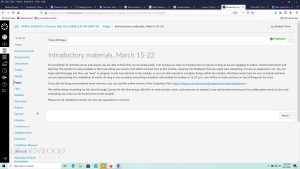
2. An example of one of the end-of-week encouragement emails I sent:
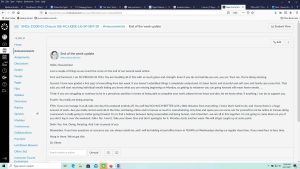
3. Two examples of the commonplace book prompts:
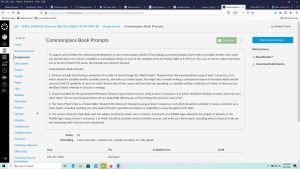
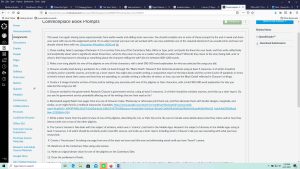
4. Example of a check-in thread:
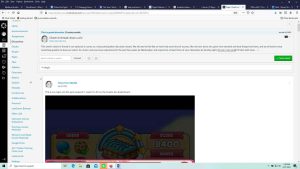
5. Example of a discussion board linked to a reading:
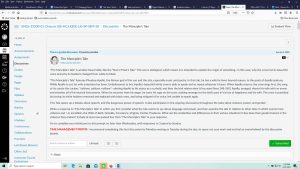
- Since 2020, our institution has made available to faculty and students licenses with Microsoft 365 and Adobe Creative Cloud, which has substantially supported online teaching and learning efforts.
- See, for example: Siân Bayne and Jen Ross, “The ‘Digital Native’ and ‘Digital Immigrant’: A Dangerous Opposition,” Annual Conference of the Society for Research into Higher Education, Brighton (2007): 321-331; Chris Jones and Binhui Shao, “The Net Generation and Digital Natives: Implications for Higher Dducation,” Higher Education Academy (York, 2011), 1-53; Kwok-Wing Lai and Kian-Sam Hong, “Technology Use and Learning Characteristics of Students in Higher Education: Do Generational Differences Exist?” British Journal of Education Technology 46, no. 4 (July 2015): 725-738; Bani Koumachi, “The Digital Turn in Higher Education: ‘Digital Natives’ Mythbusted,” International Journal of Technology in Education and Science 3, no. 1 (2019): 56-62; and Erika E. Smith, Renate Kahlke, and Terry Judd, “Not Just Digital Natives: Integrating Technologies in Professional Education Contexts,” Australasian Journal of Education Technology 36, no. 3 (2020): 1-14.
- Mark Prensky, “Digital Natives, Digital Immigrants,” On the Horizon 9, no. 5 (2001): 1-6.
- My college has since adopted this practice as a requisite aspect of good teaching following the implementation of a RISE (Rigor, Inclusiveness, Support, and Engagement) instructional model; that I began doing it prior has made this transition significantly easier for me, as well as improving my students’ understanding of what they are doing and why in my classes.
- This Commonplace Book assignment, and how I pivoted it for online instruction during the pandemic, is discussed in my article, “The Chaucerian Miscellany: A Practical, Hands-on Approach to Teaching Medieval Literature and Book Culture,” in The Once and Future Classroom 17, no.1 (Spring 2021), 1-26, https://teams-medieval.org/melissa-ridley-elmes-teams-2020-essay-prize-winner-the-chaucerian-miscellany-a-practical-hands-on-approach-to-teaching-medieval-literature-and-book-culture/.
- There has been an explosion of studies on how to manage e-learning fatigue since 2020; some representative articles include Graham Glass, “8 Tips for Educators Dealing with Digital Fatigue,” Ed Tech: Focus on Higher Education, June 18, 2021, https://edtechmagazine.com/higher/article/2021/06/8-tips-educators-dealing-digital-fatigue; Alyson Klein, “Tech Fatigue is Real for Teachers and Students. Here’s How to ease the Burden,” Education Week, March 8, 2022, https://www.edweek.org/technology/tech-fatigue-is-real-for-teachers-and-students-heres-how-to-ease-the-burden/2022/03; Anna Rutkowska et al., “Mental Health Conditions Among E-Learning Students During the Covid-19 Pandemic,” Frontiers in Public Health, May 17 2022, https://www.frontiersin.org/articles/10.3389/fpubh.2022.871934/full; Suzanne Maloney et al., “Defining and Exploring Online Engagement Fatigue in a University Context,” Computers in Education Open 4 (December 2023), https://www.sciencedirect.com/science/article/pii/S2666557323000174.
- The best resources for “one-stop shopping” towards the development of pedagogical activities using digital facsimiles are Dr. Siân Echard’s webpages. For a list of digitized Chaucer manuscript links, see her “Chaucer and Gower in Manuscript and Early Print” page: https://sianechard.ca/web-pages/chaucer-and-gower-in-manuscript-and-early-print/. For web resources for paleography, see her “Medieval Manuscripts on the Web” page: https://sianechard.ca/web-pages/medieval-manuscripts-on-the-web/.



